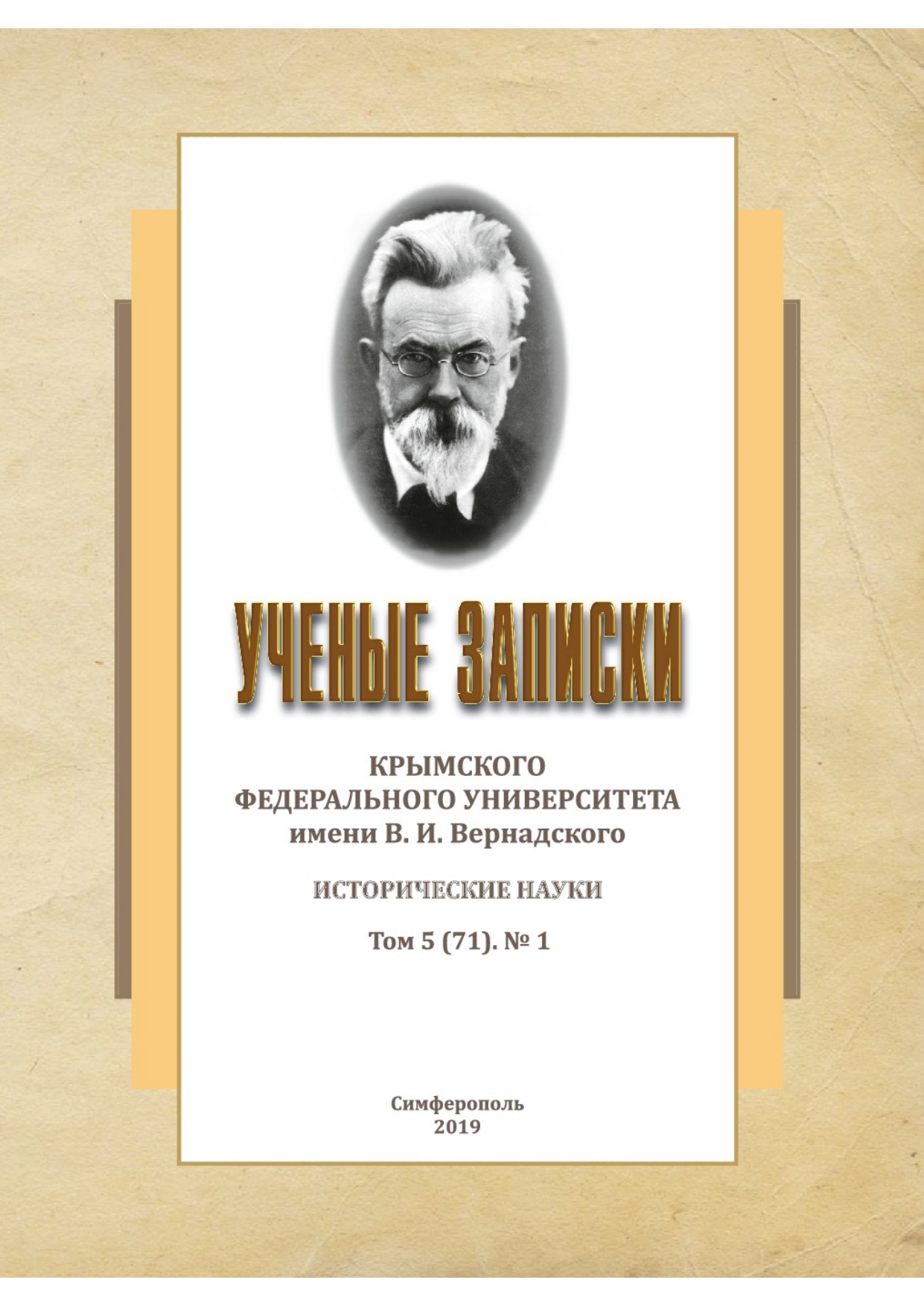Russian Federation
This article presents the history of the population of the village of Balta-Chokrak with the Southwestern Crimea, a settlement with different ethnic composition. Until the beginning of the XIX century, the village was inhabited by the Crimean Tatars, but subsequently Balta-Chokrak and its agricultural territories (cultural landscape) are bought to the treasury from the noblewoman Kalitsa Ivanovna Mazganina. After the Crimean Tatars leave the village and travel to the Ottoman Empire, a colony from Greek families who came from Anatolia is founded here. Instead of the mosque that existed in Balta-Chokrak Greek colonists build a church, and begin to actively develop agriculture. What is important, the article on the basis of archival documents and field research for the first time gave a reconstruction of the Crimean Tatar stage of the history of the village, presents the peculiarities of the structure of new immigrants, the difficulties that they had to face in a new place. The point of view established in historiography about Balta-Chokrak as a Greek-Bulgarian colony was also questioned and the features of the composition of the cultural landscape of Balta-Chokrak were revealed, the history of the construction in 1818 and subsequent rebuilding of the Panteleimon Church and the spiritual life of the colonists were detailed.
Crimea, Anatolia, Balta-Chokrak, colony, Crimean Tatars, Greeks, Bulgarians, historical geography, cultural landscape, church, mosque
1. Belov A. I. O mladencheskoy smertnosti v dorevolyucionnoy Rossii // Politicheskaya konceptologiya. – Rostov, 2017. – № 2 – S. 237–241.
2. Belova E. V. Migracionnaya politika na Yuge Rossiyskoy imperii i pereselenie bolgar v Novorossiyskiy kray i Bessarabiyu. (1751–1871 gg.) – M.: RGOTUPS, 2004. – 230 s.
3. Belova S. L. Simferopol': etyudy istorii, kul'tury, arhitektury. – Simferopol': Tavriya-plyus, 2001. – 184 s.
4. Bulychev M. Gubernator Fadeev i ego znamenitoe potomstvo // Pamyatniki Otechestva: Al'manah VOOPIK. – 1998. – № 1. – S. 30–34.
5. V Grecii umer veteran Velikoy Otechestvennoy voyny Konstantin Kanaki // RIA Novosti. 27.09.2023. URL: https://ria.ru/20230927/kanaki-1898909013.html. Provereno 15.01.2024 g.
6. Vasil'chuk V. N. Prichiny rasseleniya nemeckih poselencev na Ukraine v period carizma // Vestnik Sankt-Peterburgskogo universiteta. Seriya 2: Istoriya. – SPb., 2006. – Vyp. 4. – S. 53–61.
7. Verner K.A. Alfavitnyy spisok seleniy // Sbornik statisticheskih svedeniy po Tavricheskoy gubernii. – Simferopol', 1889. – T. 9. – 698 s.
8. Vospominaniya Andreya Mihaylovicha Fadeeva. 1790–1867 gg. – Odessa, 1897. – 256 s. Vospominaniya Andreya Mikhajlovicha Fadeeva. 1790–1867 gg. – Odessa, 1897. – 256 s.
9. Gavriil [Rozanov], arhiepiskop Hersonskiy. Hronologiko-istoricheskoe opisanie cerkvey eparhii Hersonskoy i Tavricheskoy // Zapiski Odesskogo obschestva istorii i drevnostey.
10. Gayvoronskaya O. B. Kollekciya orudiy truda bolgarskih pereselencev v sobranii Gosudarstvennogo Byudzhetnogo Uchrezhdeniya Respubliki Krym «Krymskiy etnograficheskiy muzey
11. Gancev V. K. Klassifikaciya srednevekovyh vinogradodavilen Yugo-Zapadnogo Kryma / Materialy po arheologii, istorii i etnografii Tavri. – Simferopol', 2022. – Vyp. XXVII.
12. Georgiy Kokinomati: lichnost', kotoruyu nel'zya vycherknut' iz istorii // Slava trudu. URL: https://slavatrudu-bah.ru/lyudi/206-georgij-kokinomati-lichnost-kotoruyu-nelzya-vycherknut-iz-istorii.
13. Greki Rossii i Ukrainy / otv. red. Yu. V. Ivanova. – SPb., 2004. – 624 s. Greki Rossii i Ukrainy / otv. red. Yu. V. Ivanova. – SPb., 2004. – 624 s.
14. Gosudarstvennyy arhiv Respubliki Krym (GARK). – F. 17. – Op. 2. – D. 74. – L. 1–4. Gosudarstvennyj arkhiv Respubliki Krym (GARK). – F. 17. – Op. 2. – D. 74. – L. 1–4.
15. GARK. – F. 26. – Op. 1. – D. 1747. – 63 l. GARK. – F. 26. – Op. 1. – D. 1747. – 63 l.
16. GARK. – F. 26. – Op. 1. – D. 5070. – 17 l. GARK. – F. 26. – Op. 1. – D. 5070. – 17 l.
17. GARK. – F. 26. – Op. 1. – D. 24463. – L. 1–10. GARK. – F. 26. – Op. 1. – D. 24463. – L. 1–10.
18. GARK. – F. 26. – Op. 1. – D. 24537. – L. 1–8. GARK. – F. 26. – Op. 1. – D. 24537. – L. 1–8.
19. GARK. – F. 27. – Op. 1. – D. 7382. – L. 1–9. GARK. – F. 27. – Op. 1. – D. 7382. – L. 1–9.
20. GARK. – F. 27. – Op. 1. – D. 5015. – L. 1–5. GARK. – F. 27. – Op. 1. – D. 5015. – L. 1–5.
21. GARK. – F. 118. – Op. 1. – D. 5070. – 130 l. GARK. – F. 118. – Op. 1. – D. 5070. – 130 l.
22. GARK. – F. 142. – Op. 1. – D. 2.L. – 39–64. GARK. – F. 142. – Op. 1. – D. 2.L. – 39–64.
23. GARK. – F. 142. – Op. 1. – D. 69. – 794 l. GARK. – F. 142. – Op. 1. – D. 69. – 794 l.
24. GARK. – F. 142. – Op. 1. – D. 84. – L. 91–122. GARK. – F. 142. – Op. 1. – D. 84. – L. 91–122.
25. GARK. – F. 142. – Op. 1. – D. 102. – L. 86–16. GARK. – F. 142. – Op. 1. – D. 102. – L. 86–16.
26. GARK. – F. 142. – Op. 1. – D. 115. – L. 278–306. GARK. – F. 142. – Op. 1. – D. 115. – L. 278–306.
27. GARK. – F. 142. – Op. 1. – D. 134. – L. 134–155. GARK. – F. 142. – Op. 1. – D. 134. – L. 134–155.
28. GARK. – F. 142. – Op. 1. – D. 151. – L. 40–68. GARK. – F. 142. – Op. 1. – D. 151. – L. 40–68.
29. GARK. – F. 142. – Op. 1. – D. 178. – L. 1–26. GARK. – F. 142. – Op. 1. – D. 178. – L. 1–26.
30. GARK. – F. 142. – Op. 1. – D. 190. – L. 188–219. GARK. – F. 142. – Op. 1. – D. 190. – L. 188–219.
31. GARK. – F. 142. – Op. 1. – D. 205. – L. 1–32. GARK. – F. 142. – Op. 1. – D. 205. – L. 1–32.
32. GARK. – F. 142. – Op. 1. – D. 226. – L. 176–206. GARK. – F. 142. – Op. 1. – D. 226. – L. 176–206.
33. GARK. – F. 142. – Op. 1. – D. 245. – L. 207–234. GARK. – F. 142. – Op. 1. – D. 245. – L. 207–234.
34. GARK. – F. 142. – Op. 1. – D. 260. – L. 186–218. GARK. – F. 142. – Op. 1. – D. 260. – L. 186–218.
35. GARK. – F. 142. – Op. 1. – D. 292. – L. 189–217. GARK. – F. 142. – Op. 1. – D. 292. – L. 189–217.
36. GARK. – F. 142. – Op. 1. – D. 304. – L.11–72. GARK. – F. 142. – Op. 1. – D. 304. – L.11–72.
37. GARK. – F. 142. – Op. 1. – D. 307. – L. 200–228. GARK. – F. 142. – Op. 1. – D. 307. – L. 200–228.
38. GARK. – F. 142. – Op. 1. – D. 317. – L. 1–57. GARK. – F. 142. – Op. 1. – D. 317. – L. 1–57.
39. GARK. – F. 142. – Op. 1. – D. 319. – L. 201–232. GARK. – F. 142. – Op. 1. – D. 319. – L. 201–232.
40. GARK. – F. 142. – Op. 1. – D. 331. – L. 1–43. GARK. – F. 142. – Op. 1. – D. 331. – L. 1–43.
41. GARK. – F. 142. – Op. 1. – D. 341. – L. 121–153. GARK. – F. 142. – Op. 1. – D. 341. – L. 121–153.
42. GARK. – F. 142. – Op. 1. – D. 346. – L. 1–44. GARK. – F. 142. – Op. 1. – D. 346. – L. 1–44.





